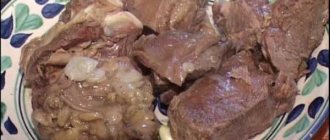Meat is considered a perishable product on which bacterial flora develops quite quickly. The best way to prolong its storage is to place it in the freezer. But it must be remembered that over time the quality deteriorates, the element of the diet loses its mass. The most valuable part - muscle fibers at low temperatures begin to dehydrate and are destroyed, as well as some of the vitamins included in its composition. That's why it's so important to know how long meat lasts in the freezer.
Let's find out!
In the freezer
According to sanitary standards, the shelf life of frozen meat products is affected by the type and amount of fat contained. Let's take a closer look at each of them.
Beef, pork, lamb
Since beef contains a large amount of tendons and muscle tissue, and there are practically no fat layers, it should be kept in the freezer for 9-10 months.
The duration of pork storage depends on the fat content in it. So frozen tenderloin will last for 8 months, and fatty pieces (for example, neck, edges) for about 7 months.
If you trim excess fat from lamb and place large pieces in the freezer, the recommended storage time will increase to 9-10 months.
By-products
The shelf life of by-products is calculated from the moment of production and is:
- 120 days for minced pork, beef, lamb, poultry.
- 180 days for liver, kidneys, stomachs, chicken hearts, beef tongue, heads.
- 60 days for home-cooked sausages and sausages in natural casings.
Bird
A whole chicken carcass will last in the freezer for a year, cut into small portions - no more than 8 months.
As for other types of poultry (turkey, goose, duck), they can be stored at low temperatures for no more than six months.
Rabbit meat
Rabbit meat is considered hypoallergenic and dietary; it is allowed to be used as complementary food for infants due to its low fat content and good digestibility. An industrial product in vacuum packaging retains its properties until the expiration date or until the container is opened; homemade, farm product – 6 months from the moment of freezing.
Seafood
Seafood (shrimp, octopus, squid, mussels, scallops, lobsters, crabs and fish (cod, salmon, tilapia)) are perishable products, so they are often frozen. The products will retain their nutritional value at -18°C for six months.
Game
Long-term storage of game (venison, elk and wild boar, etc.) is possible at low temperatures. It is necessary to freeze the gutted carcass immediately after cutting. If the temperature is maintained at a stable temperature, it will last 6-9 months.
Shelf life of different types of meat
The shelf life depends not only on the amount of salt and cooking time, but also on the type of product. Boiled and dried foods may be suitable for consumption for a different number of days:
- Boiled meat can be stored in the refrigerator for two days. If it is a lean variety, then you can keep it for up to six days.
- Smoked meat products can be stored for a long time. They can be stored in the refrigerator for up to 10 days. Smoked meats are not frozen as they become watery. If it is not possible to keep smoked meat in the refrigerator, it is placed in a cool place where the temperature does not exceed + 18 degrees. In such conditions it remains suitable for up to two days.
- Dried meat has the longest shelf life. This is an old way of cooking. This is how food was preserved in cellars. The jerky can remain edible for up to six months if kept in the refrigerator.
You can keep the baked chicken either whole or in separate parts for up to three days. The temperature should be no more than 5 degrees. To prevent chicken meat from absorbing foreign odors, it is recommended to keep it in a container with a closed lid. And about fried chicken, read How long does fried chicken last in the refrigerator?
and here read How to understand how long boiled chicken can be stored in the refrigerator
How long does fried chicken last in the refrigerator?
How long does jellied meat last?
Jellied meat, aspic, jelly are all meat dishes cooked in boiled broth. It is usually prepared in large quantities, but it is not always eaten immediately, so you need to know how to preserve it.
You need to store jellied meat in an enamel or ceramic container with a tight-fitting lid so that the product does not absorb foreign odors.
In a refrigerator
Boiled
At t +2+4 degrees, boiled food will retain its nutritional value for 2-3 days. To do this, place the piece in a container with a lid, limiting the access of oxygen. It is allowed to store the boiled product in broth.
Roast
It is recommended to place fried meats (including baked, stewed and goulash) in a container with a lid and refrigerate for no more than 2 days.
Chilled (raw) and semi-finished products
Large-piece semi-finished products, pates, cutlets, chilled tenderloin are stored for no more than 48 hours. After the specified time, freezing the raw materials is not recommended.
Pickled
The shelf life of marinated meat, including for barbecue, directly depends on the composition of the marinade. When adding natural preservatives such as vinegar, lemon juice, vegetable oils, the product can be used within 72 hours. If the product is marinated with mayonnaise, beer, kefir, or mineral water, then the period of placement in the refrigerator is reduced to 24 hours.
People's secrets of safety
If it is not possible to store the cooked product in the freezer, and you cannot eat everything, you can use traditional methods:
- In hot weather, you can preserve meat for several days using nettles. To do this, you need to wrap the piece with plant leaves.
- Brush the piece with lemon juice and place in a glass or ceramic container. Be sure to cover with a lid. This method makes it possible to preserve the freshness and taste of the product for up to two days, and in winter – up to three.
At room temperature
It can only be kept at room temperature for a short period of time. This temperature regime promotes the rapid growth of various bacteria and pathogens and protein decomposition. In order to extend the possibility of preserving meat products up to 24-36 hours at 20°C, use the following tips:
- Place in a vacuum bag and fill with ice water or cover with ice, periodically changing the warm water to cold.
- Use onions and garlic as additives in lemon and vinegar marinades.
- Soak a piece of natural linen fabric in the saline solution and wrap it around the meat product.
- You should not resort to such traditional methods as storing in milk and curdled milk, since milk itself is an excellent environment for the proliferation of pathogenic bacteria, especially at high ambient temperatures.
- During the cold season (winter, autumn), you can take the product to the balcony or basement.
- Avoid exposure to direct sunlight, try to choose the coolest and darkest place in the apartment. You can place the container under the bed or in the closet.
What GOST and SanPiN say
Technologies for raising livestock do not stand still. The producer does not want to graze animals on pastures and fatten them for 1–1.5 years. Everyone wants quick results. The introduction of synthetic amino acids into the diet of animals affects their growth rate and the quality of meat.
GOST no longer undertakes to establish storage periods and conditions. Everything is left to the discretion of the manufacturer. However, GOST regulates recommended deadlines that cannot be exceeded.
The recommended shelf life of chilled meat (beef) packaged under vacuum at a temperature of -1 to 4 °C and a humidity of 85% is no more than 25 days from the date of slaughter. This period includes the ripening period of the product, which is at least 5 days.
Other periods and conditions are indicated in the table:
Conditions and terms of storage of raw meat according to GOST
When meat enters an enterprise that produces or sells perishable products, SanPiN comes into force. It regulates storage conditions at a temperature not exceeding 6 °C (as in a household refrigerator).
In this case, the storage periods will be as follows:
Shelf life of raw meat, semi-finished products and ready-made meat dishes according to SanPiN. Click on the image to enlarge (opens in a new window)
Do you know that…
Strict requirements are imposed on finished meat products. The microflora in such products develops very quickly. Storage periods are set in hours, no more.
Determining the delay
Anyone can identify expired products if they know what to pay attention to:
- Smell. The presence of a sharp, unpleasant, sour, musty odor indicates spoilage.
- Color. Fresh, fresh meat, depending on the variety, has a shade from light pink to bright red and even brown. If you see a piece of greenish color with the presence of a white coating and suspicion of mold, refuse to use it.
- Elasticity. When pressed, a high-quality, unspoiled product quickly returns to its original shape. If the fillet darkens, is loose, with a slimy coating, this indicates its unsuitability for food.
- When purchasing, always pay attention to the integrity of the packaging and expiration dates indicated by the manufacturer. Remember that spoiled product is often used to marinate kebab or produce finished products for the culinary department.
- When purchasing a product on the market, be sure to check for a sanitary inspection stamp.
How to choose fresh
Choosing fresh meat without experience is difficult. Skilled traders perform many manipulations to sell their stale goods. It is even more difficult to choose fresh meat that is not purchased very often. For example, rabbit, nutria, goat or moose.
To avoid mistakes, you can use the following recommendations:
- Externally, fresh meat should have a dry dry crust. If it is sticky and darkened, this indicates questionable freshness. The stale product is dark, gray-brown, very dried out.
- Fresh fat is light, white or yellowish, almost odorless. Beef crumbles, pork has a spreadable consistency. Old meat will have gray fat and a rancid smell.
- When cutting into the muscle, fresh meat will not leave a mark on the filter paper. A stale product will be sticky and will certainly leave a mark.
- The consistency of the steamed pulp is elastic. If you press, the muscles spring back and the dent quickly levels out. In case of questionable freshness, the dent is leveled out slowly, and the old one does not fill the hole left by the finger.
- The smell of a fresh product will be specific, characteristic of the animal species.
Tip of the day
They still don’t know how to change the smell of meat. Stale - smells sour, this is the result of the proliferation of acid-forming bacteria. Be sure to smell the product when purchasing. If you have doubts, don’t buy.
The broth will also help determine the freshness of the meat. If you boil a benign piece, the liquid you get will be:
- fragrant;
- transparent;
- with a small amount of small “flakes”.
Meat that creates turbidity and a sharp, unpleasant smell of broth is not fresh.
Recommendations and lifehacks
In order to avoid spoilage of meat products ahead of time, adhere to the following recommendations:
- Remember that fatty varieties spoil faster, plan your purchases and menu wisely.
- Repeated deep freezing is prohibited. Therefore, fresh raw materials must first be cut into small portions and packaged in bags or wrapped in cling film and only then frozen.
- Be sure to label the contents of plastic bags, indicating the date, time and type of item.
- Adding salt increases shelf life.
- Thaw meat properly to maximize quality and texture. To do this, first place it on the refrigerator shelf to completely defrost.
- Small pieces spoil faster.
- To place it in a refrigerator, do not pack it in a vacuum bag: the meat must breathe. An enamel bowl with a lid or a loosely sealed glass jar is best.
- Sun-dried, smoked, salted, dried, raw smoked meat is not stored in the freezer, since this causes the appearance to be lost when defrosted due to the formation of a large amount of moisture.
- Marbled beef steaks should not be frozen.
- Maintain product proximity in accordance with the hygienic standards of SanPiN and GOST.
- Do not forget that consuming expired raw materials can lead to severe intoxication and poisoning, even death.
How to store raw food: terms, conditions, packaging
The refrigerator is a wonderful invention. However, this kitchen unit is young, and people have previously tried to preserve the product for as long as possible.
In the old days, salt and herbs and nettles were used as preservatives. However, nothing can compare to the cold
Interesting fact
You can store meat without a refrigerator, but only during its ripening period. Further, above-zero temperatures promote the proliferation of microflora and spoilage of the product.
How to prepare (does it need to be washed)
Meat brought from the market or store should not be washed. It is better to do this before cooking.
If you plan to cook the meat within 1-2 days, place it in a bag or container and place it in the refrigerator. If there is more product than needed, it is better to put it in the freezer.
In a refrigerator
The refrigerator is the only place for safe storage. The bottom shelf is best suited for this purpose. If you know exactly when livestock or, for example, a rabbit was slaughtered, then the storage period is determined from the moment of slaughter. This meat can be stored for 4–5 days.
If the moment of slaughter is unknown (the sticker on the package cannot always be trusted), then it is better not to store it for longer than 1–2 days.
In the freezer
Although there are shelf life limits for frozen meat, it is theoretically possible to store the product until defrosted. This is how strategic reserves are created for years. However, the longer meat sits in the freezer, the more tasteless it will be after defrosting and cooking.
Fresh meat should not be frozen. After slaughter, it is better to let it ripen and rest in the refrigerator for 1–2 days. Next, pack it in paper, a bag or container and put it in the freezer.
Note to the hostess
You can also freeze semi-finished products. Cut the piece into pieces, beat it, wrap it in portions and put it in the freezer.
After defrosting
It is better to defrost meat gradually. It needs to be removed from the chamber and moved to the refrigerator, where it can be stored for another day after complete defrosting until processing. Or put it in cold water.
But repeated freezing is unacceptable.
Without a refrigerator, on the road
Now there are thermal bags and thermal bags. If you don’t have such devices, you can use ice:
- Plastic bottles of water are frozen and placed in a container along with the meat.
- Then everything is well packaged.
Such storage is possible until the ice melts and the water begins to heat up. If the road is long, don’t take risks.
We recommend reading: Food thermal bags: 5 uses you didn’t know about.
[flat_ab id=”42"] [f[flat_ab id=”43"]p>
Various storage methods, tricks and inventions find no justification - meat without refrigeration quickly spoils
In a vacuum
Vacuum packaging is quite specific. Without knowing the conditions under which packaging was carried out, it is unrealistic to talk about storage times and conditions. Therefore, GOST leaves this to the discretion of the manufacturer. Only he knows:
- what they pack in;
- how and with what meat is processed;
- How does the microflora behave in the packaging?
The manufacturer receives all this knowledge on the basis of serious laboratory research. The results are taken into account and recorded in the specifications, which the manufacturer must follow.
It is important to know!
The packaging must indicate the date of manufacture or “use by”. This marking should be followed impeccably. However, after opening it is necessary to carry out an organoleptic analysis - to evaluate the smell.
How long does it take for meat to spoil?
The following are stored at a temperature of minus 25°C: beef - 18 days, pork and lamb - 12, poultry meat - 14, beef offal - 10, pork offal - 6, lamb offal - 8 days. The following are stored at minus 20°C: beef - 14 days, pork - 7, lamb - 11, poultry - 12, beef and lamb offal - 7, pork - 5 days.
Interesting materials:
Which side is the front side of banknotes? What is the country of manufacture based on the barcode? What is the structure of the Universe? What is the daily dose of zinc for humans? Which tachycardia is the most dangerous? What is the probability that twins will be born? What is the probability of contracting HIV in a condom? What thing does not transmit sound? What is the height of the chain-link mesh? What salary is stated in the employment contract?
Is it possible to freeze raw smoked meat?
Dried meat can be stored in the freezer for up to six months. If you need to preserve your jerky for a long time, place it in the freezer. This will extend the shelf life of the product, but the taste of the meat may change.
Interesting materials:
How to log out of Telegram desktop? How to log out of your Viber account on a computer? How to exit an application on an iPhone without the Home button? How to wake up from sleep mode on a laptop? How does ear wax come out? How to lay out acrylic gel? How to unscrew a bolt in a recess? How to unscrew a light bulb in a suspended ceiling? How to check out using my documents? How to leave your registration?
How to make already fried meat tender?
You can revive dry and tough meat using a water bath. To do this, take it out of the oven, drain it in a colander and place it on a pan of boiling water for 10-15 minutes. This time is enough for the finished meat to absorb moisture and, as a result, become much juicier and softer.
Interesting materials:
Is it possible to withdraw money from Kaspi wallet? Is it possible to shoot a film in a cinema? Is it possible to transfer from Sberbank to RNKB? Is it possible to transfer from Sberbank to PayPal? Is it possible to transfer from Sberbank to Ukraine? Is it possible to pick cherries after rain? Is it possible to combine amoxicillin and azithromycin? Is it possible to combine residency and postgraduate studies? Is it possible for a 4 month old baby to sleep on his stomach? Is it possible to install DDR3 and DDR4 together?











